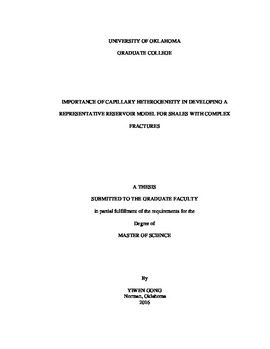| dc.description.abstract | Our advancement in hydraulic fracturing has enabled us to produce shale formations economically. The formation stimulation is successful when the effective transport properties of the formation is improved significantly, which is achieved usually by creating multiple intersecting curved (complex) fractures in tight formations. The transport mechanisms are fundamentally different from those of high-permeable (conventional) formations since the fracture-matrix contact surface, which is often curved, is much larger. The difference between the transport properties of the matrix and the fractures is also more significant, in shales, which adds another complexity to this problem.
Our main objective in this research is to determine the importance of a formation heterogeneity on the estimated ultimate recovery (EUR) of a shale formation. We determine the accuracy of the reduced model. We also analyze hydrocarbon production from shales with complex fractures based on the fracture cell model (Sakhaee-Pour and Wheeler, 2016). The fracture cell model accounts for the effects of multiple intersecting curved (complex) fractures on the transport properties. It takes different representations for the relative permeability and the capillary pressure of the matrix and the fracture. Further, we use a geostatistically representative model to account for the formation heterogeneity as it relates to the porosity, permeability, and capillary pressure.
Our study shows that the capillarity heterogeneity plays a dominant role in estimated ultimate recovery (EUR) of shales, whereas the effects of permeability and porosity heterogeneity is less important. The local trapping caused by the capillary heterogeneity in all cases helped the pressure drop of the reservoir in early time and mitigate the cumulative oil production in later time. | en_US |
